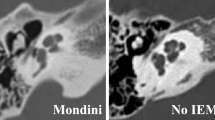Abstract
Objectives
To evaluate the effect of electrical auditory brainstem response (EABR) on the integrity evaluation of auditory pathway and the prediction of postoperative effect of cochlear implantation in patients with different etiology of hearing loss.
Methods
A total of 580 patients with neuropathic deafness who underwent cochlear implantation surgery from August 2011 to December 2020 were selected for EABR test. The preoperative EABR waveform was analyzed, and parameters such as V wave amplitude, threshold, latency and interval of each wave, and slope of V wave I/O curve were measured. Neural response telemetry (NRT) test was performed during MAP 1 month after operation, and C and T values of the machine were recorded.
Results
The total EABR extraction rate was 98.45% among 580 patients, including 100% for the normal structure group and enlarged vestibular aqueduct group (LVAS), 92.44% for other malformed group. The average threshold of V wave in patients with normal cochlear structure was significantly better than the malformation groups (p < 0.05). The total extraction rate of NRT was 78.62%, including 99.72% in the group with normal structure, 95.65% in the LVAS group, 1.85–88.24% in the group with other malformations, and 0% in the cochlear ossification group. The correlation analysis showed a statistically significant correlation between the average preoperative EABR threshold and the C value of NRT.
Conclusions
Preoperative EABR could evaluate the integrity of auditory conduction pathway of patients with cochlear implantation and predict the postoperative hearing rehabilitation effect.


Similar content being viewed by others
Availability of data and materials
All data generated or analysed during this study are included in this article. Further enquiries can be directed to the corresponding author.
References
Layer N, Weglage A, Müller V et al (2022) The timecourse of multisensory speech processing in unilaterally stimulated cochlear implant users revealed by ERPs. Neuroimage Clin 34:102982
Scheperle RA, Hajicek JJ (2020) Wideband acoustic immittance in cochlear implant recipients: reflectance and stapedial reflexes. Ear Hear 41(4):883–895
Chen L, Zhang JG, Zhu HY et al (2023) Electrically evoked auditory brainstem responses in children fitted with hearing aids prior to cochlear implantation. Trends Hear 27:23312165221148850
Starr A, Brackman DE (1979) Brainstem potentials evoked by electrical stimulation of the cochlear in human subjects. Ann Otol Rhinol Laryngol 88(4 Pt 1):550–556
Gibson WP, Sanli H, Psarros C (2009) The use of intraoperative electrical auditory brainstem response to predict the speech perception outcome after cochlear implantation. Cochlear Implant Int 10(Suppl 1):53–57
Wang B, Cao K, Wei C et al (2019) Evaluating auditory pathway by electrical auditory middle latency response and postoperative hearing rehabilitation. J Invest Surg 32(6):542–551
Wang B, Guo X, Cao K, Wei C, Gao Z, Wang S (2023) Evaluation of auditory pathway by EABR before cochlear implantation and the postoperative effect analysis. Eur Arch Otorhinolaryngol 280(1):105–114
Kileny PR, Zwolan TA, Zimmerman-Phillips S et al (1992) A comparison of round-window and transtympanic promontory electric stimulation in cochlear implant candidates. Ear Hear 13(5):294–299
Jeon JH, Bae MR, Song MH et al (2013) Relationship between electrically evoked auditory brainstem response and auditory performance after cochlear implant in patients with auditory neuropathy spectrum disorder. Otol Neurotol 34(7):1261–1266
Dutt SN, Kumar A, Mittal AA et al (2021) Cochlear implantation in auditory neuropathy spectrum disorders: role of transtympanic electrically evoked auditory brainstem responses and serial neural response telemetry. J LaryngolOtol 135(7):602–609
Song MH, Bae MR, Kim HN et al (2010) Value of intracochlear electrically evoked auditory brainstem response after cochlear implantation in patients with narrow internal auditory canal. Laryngoscope 120(8):1625–1631
Wang Z, Liu Y, Wang L et al (2018) Characteristics of electrically evoked auditory brainstem responses in patients with cochlear nerve canal stenosis receiving cochlear implants. Int J Pediatr Otorhinolaryngol 104(1):98–103
Guedes MC, Brito Neto RV, Gomez MV et al (2005) Neural re- spons e telemetry measures in patient implanted with Nucle24. Braz J Otorhinolaryngol 71(5):660–667
Schvartz-Leyzac K, Zwolan T, Pfingst B (2021) Using the electrically-evoked compound action potential (ECAP) interphase gap effect to select electrode stimulation sites in cochlear implant users. Hear Res 406:1–13
Maxwell AP, Mason SM, O’Donoghue GM (1999) Cochlear nerve aplasia: its importance in cochlear implantation. Am J Otol 20(3):335–337
Lammers MJ, van Eijl RH, van Zanten GA (2015) Delayed auditory brainstem responses in prelingually deaf and late-implanted cochlear implant users. Assoc Res Otolaryngol 16(5):669–678
Pfingst BE, Hughes AP, Colesa DJ (2015) Insertion trauma and recovery of function after cochlear implantation: evidence from objective functional measures. Hear Res 330(Pt A):98–105
Nikolopoulos TP, Mason SM, O’Donoghue GM et al (1997) Electric auditory brain stem response in pediatric patients with cochlear implants. Am J Otol 18(6 Suppl):S120–S121
Funding
This study supported by National High Level Hospital Clinical Research Funding (No. 2022-PUMCH-A-031).
Author information
Authors and Affiliations
Contributions
KC conceived of the study, and BW, XG and CW participated in its design and data analysis and statistics and Wang X helped to draft the manuscript. All authors read and approved the final manuscript.
Corresponding author
Ethics declarations
Conflict of interest
All of the authors had no any personal, financial, commercial, or academic conflicts of interest separately.
Ethical approval and consent to participate
This study was conducted in accordance with the Declaration of Helsinki and approved by the ethics committee of Peking Union Medical College Hospital. Written informed consent was obtained from all participants.
Consent for publication
Not applicable.
Additional information
Publisher's Note
Springer Nature remains neutral with regard to jurisdictional claims in published maps and institutional affiliations.
Rights and permissions
Springer Nature or its licensor (e.g. a society or other partner) holds exclusive rights to this article under a publishing agreement with the author(s) or other rightsholder(s); author self-archiving of the accepted manuscript version of this article is solely governed by the terms of such publishing agreement and applicable law.
About this article
Cite this article
Wang, B., Guo, X., Wei, C. et al. Preoperative EABR evaluation of auditory pathway integrity in patients with different etiology and postoperative effect estimation. Eur Arch Otorhinolaryngol 281, 1185–1193 (2024). https://doi.org/10.1007/s00405-023-08198-0
Received:
Accepted:
Published:
Issue Date:
DOI: https://doi.org/10.1007/s00405-023-08198-0




